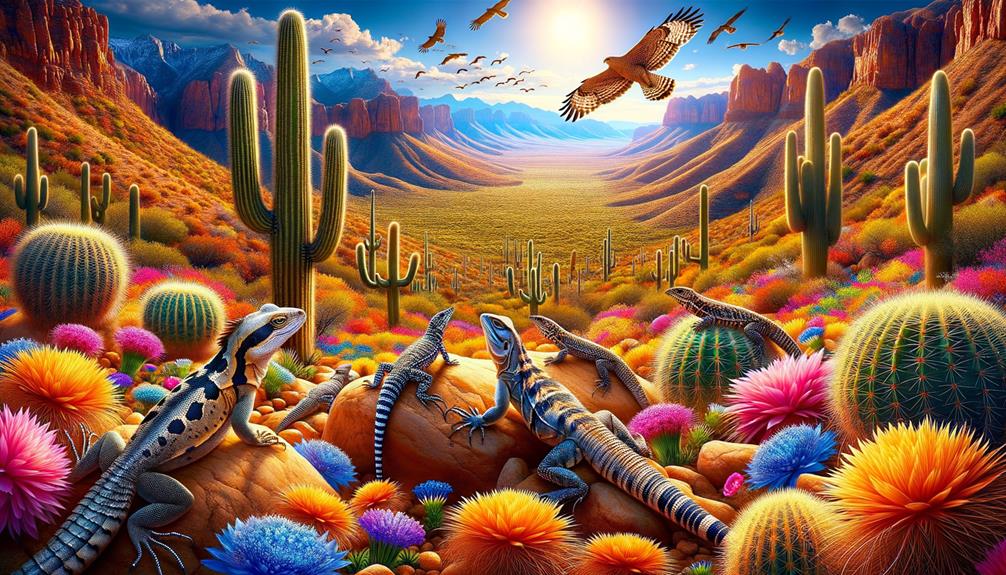Did you know Gila monsters can go without food for months? They store fat in their tails, a clever trick that helps them survive in the harsh Sonoran Desert. These eye-catching reptiles are the biggest lizards in America and the only ones with venom in the United States. They play a key role in their ecosystem, hunting small mammals and adapting to tough desert life. There's a lot to learn about where they live, how they've evolved, and even the makeup of their venom. Want to know more about how these tough creatures thrive in such a dry place?
Identifying Characteristics
Gila monsters stand out in the Sonoran Desert with their eye-catching pink or orange and black warty skin. These chunky lizards have a unique look that's hard to miss. Their small, beady eyes and short, thick tails add to their distinctive appearance, while their sharp claws help them dig burrows and hunt for eggs.
In the American Southwest, the Gila monster's vibrant skin isn't just for show—it's a clever camouflage that helps them blend into the rocky, sandy desert landscape. Their tails serve a dual purpose, providing balance and storing fat to help them survive when food is scarce.
Perhaps the most intriguing feature of the Gila monster is its venomous bite. As one of only two venomous lizards in North America, a bite from this creature can cause serious discomfort, including pain, swelling, and nausea. This characteristic, combined with their unique appearance, has led to their protected status in several states, helping ensure their survival in their native habitats.
Natural History
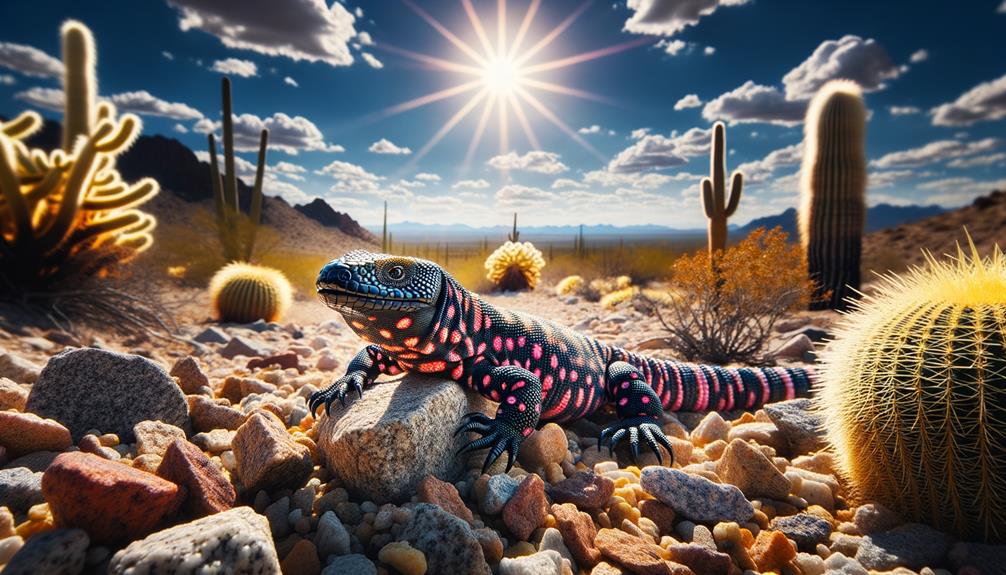
Let's talk about Gila monsters. These fascinating creatures aren't your average backyard lizards. Native to the Sonoran Desert, they're the biggest lizards you'll find in America and the only ones that pack a venomous punch in the U.S. You can't miss them with their eye-catching pink or orange colors, topped off with black, bumpy scales.
In their desert home, Gila monsters play a key role. They munch on other lizards, rodents, birds, and even raid nests for eggs. This varied menu helps keep other animal populations in check, maintaining the desert's delicate balance. These clever reptiles have a neat trick up their sleeves too. They store fat in their tails, which comes in handy during food shortages, winter naps, and even when they're expecting little ones.
| Feature | Fact |
|---|---|
| Size | Largest lizard in America |
| Venom | Only venomous lizard in the U.S. |
| Food | Eats lizards, rodents, birds, bird eggs |
Understanding these unique lizards gives us a glimpse into the intricate workings of desert life. Their survival strategies and role in the ecosystem showcase nature's ingenuity in harsh environments.
Distribution and Habitat
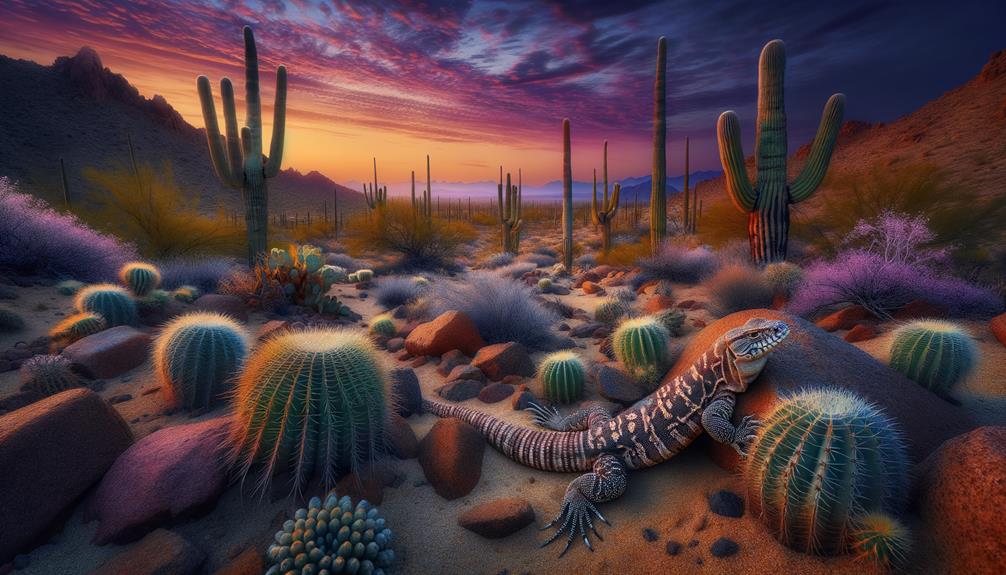
Gila monsters call the southwestern U.S. and northern Mexico home, proving they can handle the tough desert life. You'll spot these tough lizards from western and southern Arizona all the way to southern Sonora, Mexico, with a few hanging out in southwestern Utah and southern Nevada. They're not picky about their digs, making do in desert scrub, mountain areas, and dry riverbeds.
These hardy creatures set up shop in:
- Mountain spots: They love areas with saguaro cacti and palo verde trees, which offer great hideouts and snacks.
- Dry riverbeds: These stretch into valleys, giving the lizards a mix of gravel and sand that's perfect for digging.
- Scrubby desert: The shrubs in the Mojave, Sonoran, and Chihuahuan deserts make for good hiding spots and hunting grounds.
- Holes in the ground: Whether they dig them themselves or move into empty ones, these holes keep them safe from predators and nasty weather.
Gila monsters are tough cookies. They've figured out how to eat at night and store fat to get through winter. You'll often catch them chilling under rocks or in their holes, but they're pretty good at getting around the dry landscape too. These lizards are the real deal when it comes to surviving in places where most creatures would throw in the towel.
Reproduction
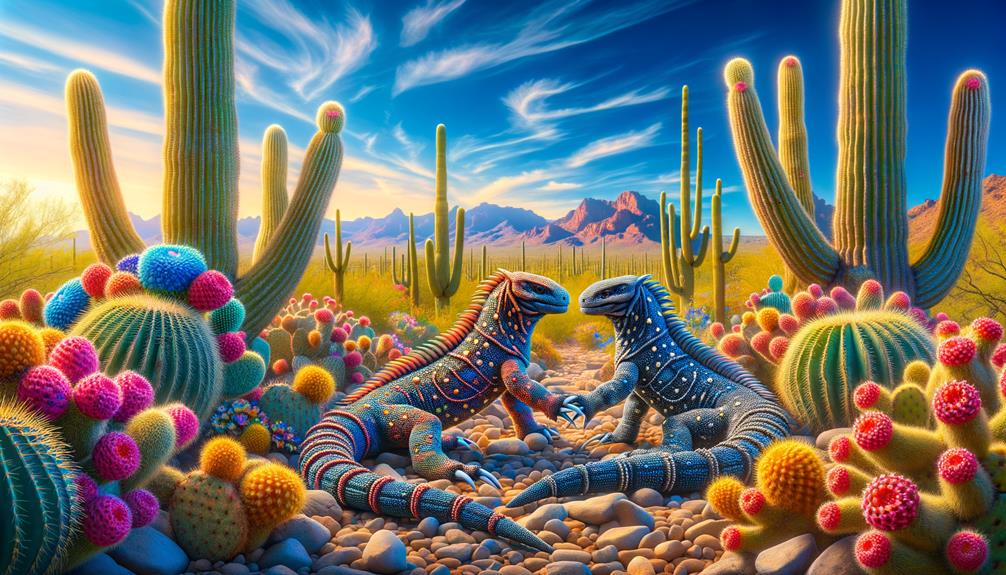
Gila monsters start their mating rituals in summer. Come fall or winter, females lay 3 to 5 eggs in carefully chosen spots. They pick sandy soils, burrows, or areas under rocks that offer protection and the right conditions for their eggs.
The small clutch size is a smart move. It allows each egg to get the best care and resources, boosting the odds of successful hatching. By the cooler months, these eggs are tucked away safely, waiting for the perfect moment to hatch.
Timing is crucial for these reptiles. They've adapted over time to ensure their young emerge when conditions are just right. This careful approach to breeding shows how Gila monsters have learned to thrive in the tough Sonoran Desert environment.
Their reproductive strategy highlights the species' knack for survival. It's a testament to how these creatures have fine-tuned their life cycle to match their harsh habitat. This method has helped Gila monsters persist in an ecosystem where many other species might struggle.
Feeding Behavior
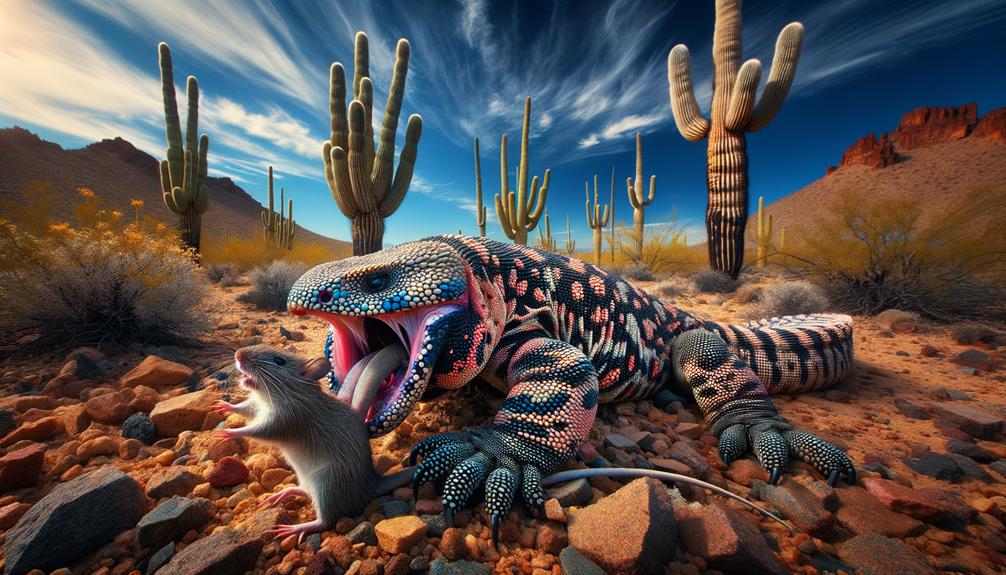
Gila monsters are fascinating creatures with unique eating habits tailored to their Sonoran Desert home. These lizards come alive at night, hunting when temperatures cool. Their diverse diet helps them thrive in a challenging environment.
These reptiles have a powerful bite, crucial for catching and eating their prey. Their menu typically includes:
- Small mammals like mice and rats
- Birds, especially young ones or those nesting on the ground
- Eggs, which pack a nutritional punch
- Other reptiles, including smaller lizards
But Gila monsters don't just eat for the moment. They're excellent at storing fat from their meals, allowing them to go long stretches without food when prey is scarce. This adaptation is key to their survival in the desert's harsh conditions.
Predation
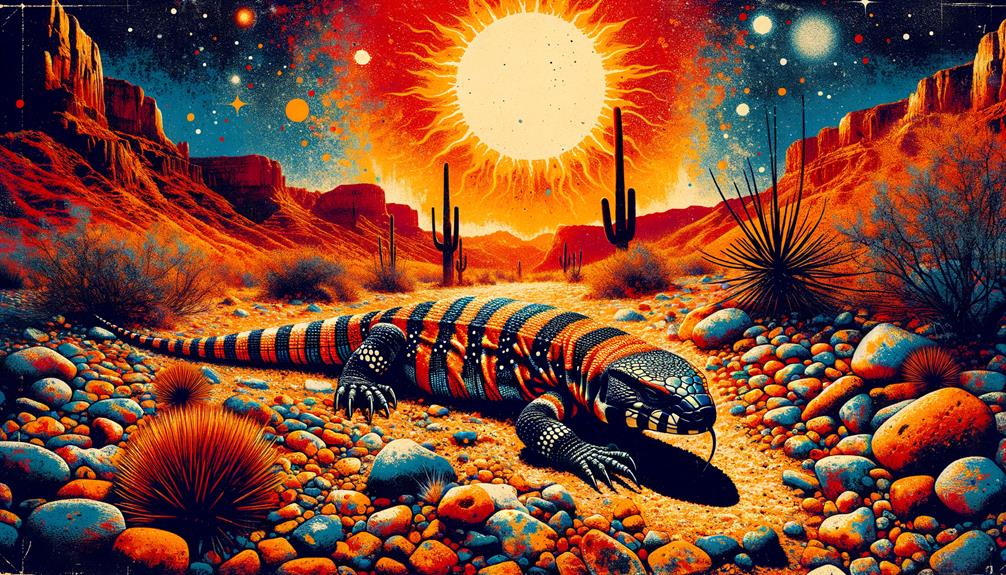
Gila monsters in the Sonoran Desert face an array of challenges, but their natural defenses help them survive. These lizards pack a venomous bite and sport tough, armored skin, which ward off many would-be attackers like coyotes and snakes. While birds of prey occasionally pose a threat, the real danger comes from human activity. Habitat loss and illegal capture for the pet trade have become more pressing concerns for these unique reptiles than their natural predators. It's a stark reminder of how human interference can upset the delicate balance of desert ecosystems, putting even well-adapted species at risk.
Natural Predators of Gila
Gila monsters, despite their tough exterior and venomous bite, aren't invincible in the harsh Sonoran Desert. A few gutsy predators still take their chances against these resilient lizards.
Who's brave enough to tangle with a Gila monster? Let's take a look:
Rattlesnakes: These slithery desert dwellers occasionally go head-to-head with Gilas, risking a venomous counterattack.
Hawks and Eagles: With sharp eyes and powerful talons, these birds sometimes swoop down on unsuspecting Gilas, aiming to avoid their defenses.
Coyotes: Quick and clever, coyotes might target Gilas, using their speed to outmaneuver the lizards' protective mechanisms.
Humans: While not part of the natural food chain, people pose a threat through habitat loss and illegal collection, putting pressure on Gila populations.
In the Sonoran ecosystem, the Gila monster's defenses are crucial for survival. Their armored skin and toxic bite make them a tough target, keeping predator encounters rare. The lizard's bright colors serve as a warning sign, advertising its potent defenses to potential threats.
Gila Defensive Mechanisms
Gila monsters are tough creatures that have a few tricks up their sleeves when it comes to staying safe in the Sonoran Desert. Their bite is no joke – once they latch on, they're not letting go easily. This tenacious grip, paired with venom, can make even the boldest predators think twice.
Their skin is like nature's own bulletproof vest. Under those scales, they've got bony plates called osteoderms. It's as if they're wearing a suit of armor, making it hard for anything to pierce through.
But it's not all about physical toughness. These lizards have a bit of attitude too. When they're bothered, they'll let out a hiss that serves as a clear "back off" message to potential threats.
All these defenses combined make the Gila monster a real survivor in the harsh desert environment. They're not just hanging on – they're thriving out there, proving themselves to be one of the toughest critters in the Sonoran Desert.
Human Impact on Predation
People have significantly changed how Gila monsters hunt and survive in the Sonoran Desert. Losing their homes, getting hit by cars, and being caught for illegal sales are big problems for these lizards. These issues make it tough for Gila monsters to live their normal lives in an already challenging desert environment.
Let's look at how people affect Gila monsters:
- Losing Homes: As cities grow and farms expand, Gila monsters have less space to find food and shelter.
- Car Accidents: More cars in the desert mean more Gila monsters die trying to cross roads.
- Illegal Catching: Some people catch Gila monsters to sell as pets or for their special venom, which hurts their numbers in the wild.
- Helping Out: There are efforts to protect Gila monsters by setting up safe areas, stopping poachers, and helping injured animals recover.
We need to work on protecting these lizards and teaching people about them. By showing others how to act responsibly, we can create a better place for Gila monsters to live. Understanding and fixing these human-caused problems is key to keeping these fascinating creatures around in the Sonoran Desert for years to come.
Venom and Bites
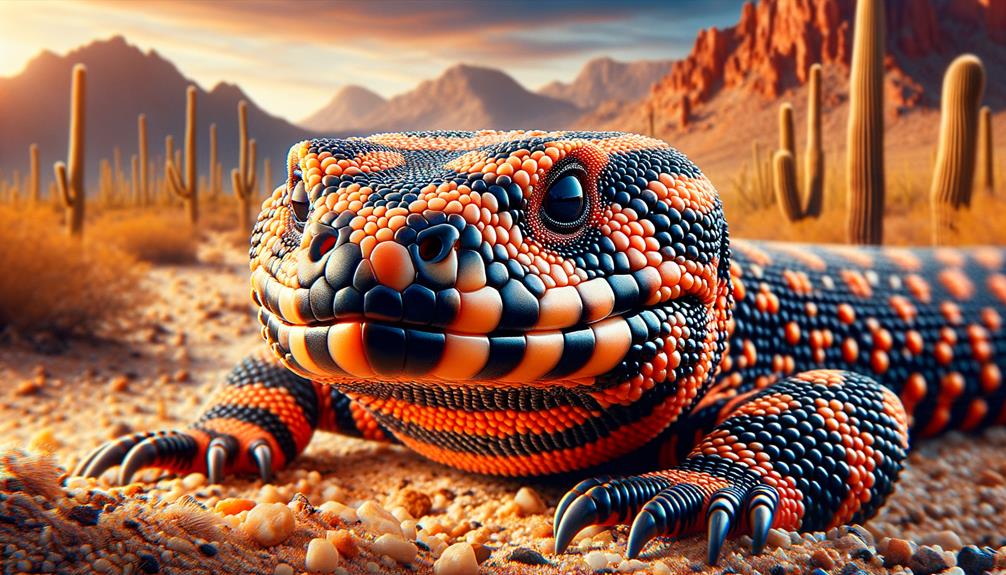
Gila monsters don't bite often, but when they do, it's no joke. Their powerful venom, delivered through grooved teeth, can cause intense pain and swelling. These unusual lizards have venom glands in their lower jaws that produce toxic saliva. The venom serves mainly as a defense mechanism rather than for hunting. While bites are uncommon, usually happening when the lizard feels threatened, the results can be severe.
When a Gila monster chomps down, it doesn't let go easily. This tenacious grip allows for continuous venom injection, making the experience exceptionally painful for the victim. The venom causes immediate discomfort and swelling, with symptoms potentially worsening if left untreated. It's crucial to get medical help right away to manage the effects and prevent complications.
Despite their scary reputation, Gila monsters aren't typically aggressive. They'd rather avoid conflict, and bites are rare occurrences. Still, understanding the potential risks highlights why it's important to give these unique reptiles space. Their venom glands and toxic saliva showcase nature's clever design for self-defense, even in creatures that rarely show aggression.
Conservation and Protection
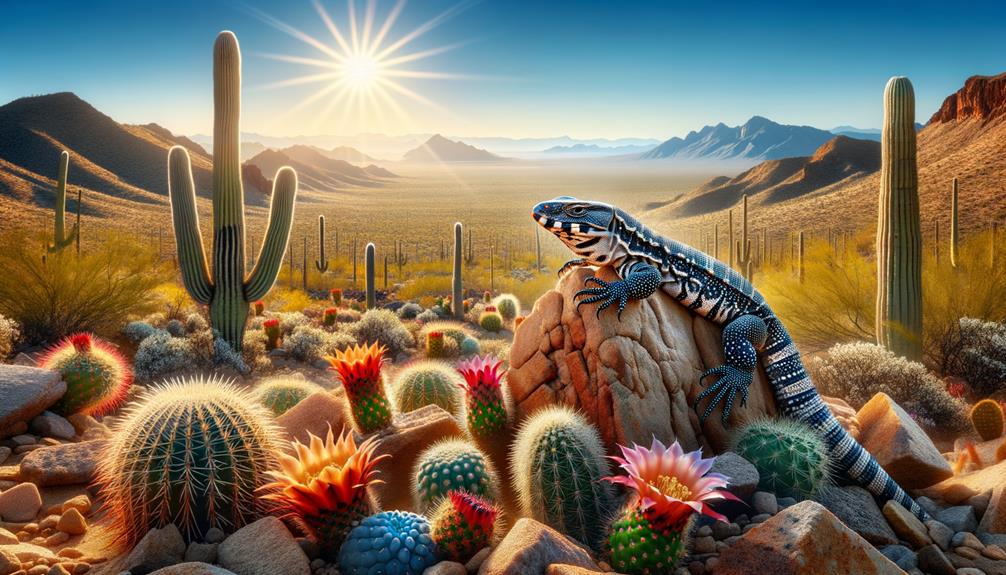
Protecting Gila Monsters requires a two-pronged approach: preserving their natural habitats and cracking down on illegal hunting. While these impressive lizards are protected by law, both locally and internationally, their future depends on maintaining their desert homes and stopping poachers. By zeroing in on these crucial areas, we can ensure Gila Monsters continue to roam the Sonoran Desert for years to come.
State regulations and global agreements offer a solid foundation for Gila Monster conservation, but the real work happens on the ground. Safeguarding their habitats means preserving the unique ecosystem of the Sonoran Desert, where these reptiles have evolved to thrive. At the same time, robust anti-poaching measures are essential to combat the illegal wildlife trade that threatens many rare species.
Conservationists and local communities play a vital role in these efforts. By working together to monitor Gila Monster populations, restore damaged habitats, and educate the public about these fascinating creatures, we can make a real difference. It's a challenging task, but one that's crucial for maintaining the biodiversity of the American Southwest.
Habitat Preservation Efforts
Protecting Gila Monsters isn't just about the reptiles themselves – it's about preserving a vital piece of the Sonoran Desert ecosystem. Laws at both state and international levels are key to keeping these unique creatures thriving in their natural home. Conservation work is crucial, keeping tabs on trade and making sure Gila Monsters stay off-limits to collectors. By focusing on where they live and how they spread out, we can better fight against illegal activities that put them at risk. Here's how we're tackling this from different angles:
- Keeping Trade in Check: The Gila Monster's spot on CITES Appendix II means any international buying and selling is watched closely, preventing them from being over-harvested.
- State-Level Safeguards: Places like Arizona, California, and Utah have tough rules against nabbing, killing, or selling Gila Monsters, giving them a legal safety net.
- Protecting Their Turf: By safeguarding the Sonoran Desert, we're making sure Gila Monsters can keep doing their thing in the environment they're built for.
- Spreading the Word: Teaching folks about why Gila Monsters matter and what's putting them in danger helps create a group of people who'll stand up for these lizards.
Anti-Poaching Initiatives
Protecting Gila Monsters goes beyond safeguarding their habitat. Strengthening efforts to combat poaching is key to preventing these unique reptiles from being snatched from the wild and sold illegally. These anti-poaching measures serve as the primary defense against underground trade of these fascinating creatures. While CITES Appendix II strictly regulates their international trade, local enforcement plays an equally vital role.
Laws in California, Nevada, Utah, New Mexico, and Arizona offer strong legal shields, making it a crime to collect, harm, or sell Gila Monsters in these areas. Arizona, home to a significant portion of the species' range, has particularly tough rules, showcasing the state's dedication to preserving this distinctive reptile. These laws don't just punish offenders; they also give wildlife agencies the power to conduct regular patrols and undercover operations to catch poachers in the act.
Conservation work extends beyond legal protections. Public education campaigns play a crucial role in helping people understand why these reptiles matter to the Sonoran Desert ecosystem. Getting involved with local conservation groups is a great way to back these anti-poaching efforts and legal safeguards. Only through teamwork can we ensure Gila Monsters continue to thrive in their natural habitat, safe from the threat of poaching.
Frequently Asked Questions
Do Gila Monsters Live in the Sonoran Desert?
Gila monsters call the Sonoran Desert home. These reclusive reptiles thrive in the harsh landscape, making their way through rocky foothills and underground burrows. Arizona law protects these creatures, recognizing their importance to the desert ecosystem. The Sonoran's unique plant life and animal population create just the right conditions for Gila monsters to hunt and survive. Their presence adds to the rich tapestry of desert life, making the Sonoran a fascinating habitat for nature enthusiasts and researchers alike.
What Is the Only Venomous Lizard in the Sonoran Desert?
The Gila Monster stands out as the sole venomous lizard inhabiting the Sonoran Desert. Its bite packs a punch, causing discomfort, swelling, and queasiness. This eye-catching reptile, safeguarded by local regulations, sports a distinctive bead-patterned skin that helps it blend into its rugged surroundings. Despite its fearsome reputation, the Gila Monster plays a crucial role in the desert ecosystem, reminding us of nature's intricate balance in even the harshest environments.
Where Are Gila Monsters Found in Arizona?
Curious about Gila Monsters in Arizona? These distinctive reptiles call the western and southern parts of the state home. You'll spot them in grassy foothills and desert scrublands, where they thrive. These creatures favor dry areas dotted with palo verde trees and towering saguaros. Valley washes also provide ideal spots for them to hunt and seek shelter. If you're keen to observe these fascinating lizards in their natural habitat, these are the landscapes to explore. Remember, Gila Monsters play a crucial role in Arizona's ecosystem, so it's best to admire them from a respectful distance.
Are There Gila Monsters in the Mojave Desert?
Gila Monsters do call the Mojave Desert home. These unique reptiles have adapted well to the harsh, dry environment. You'll often find them tucked away under rocks or in burrows during the day. When night falls, they come out to hunt for food. Their bodies are designed to store fat, which helps them survive the tough desert conditions. It's fascinating how these creatures have found ways to thrive in such a challenging landscape.



